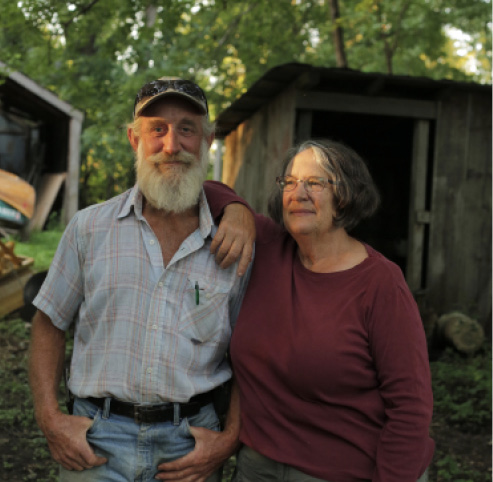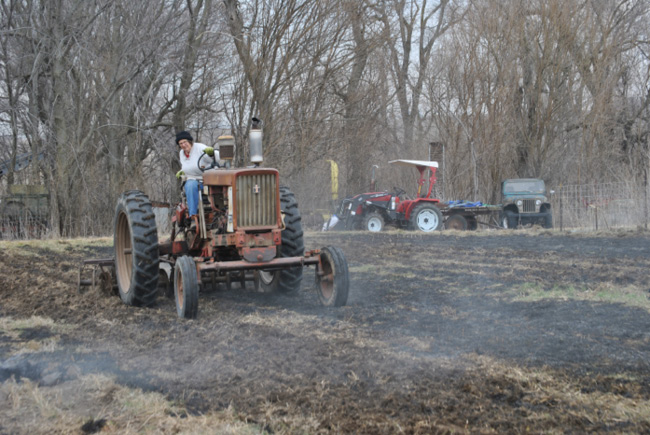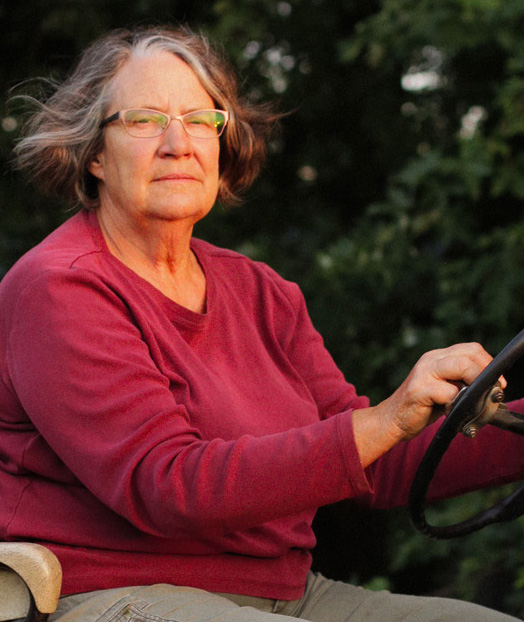Oats, peas, beans and barley grow.
Oats, peas, beans and barley grow
Do you or I or anyone know
How oats, peas, beans and barley grow?
First the Farmer sows the seed
Then he stands and takes his ease
He stamps his foot and claps his hands
And turns around to view his lands.
There was no honeymoon for Larry and me after our early morning spring wedding. The guests had returned home, and our house was quiet after the festivities of the weekend. The baby pigs were nestled in their pens with their mothers’ providing them with meals on demand. The pregnant cows were feasting on their breakfast of ground corn. We headed up to the home place that Lyle and Delma Harris established in 1949, to prepare the machinery for planting oats. They are sown in March, the first seedlings of the growing season. They can germinate in 40 degree soil. The corn and beans that follow require warmer temperatures.
“You’ll be close by, right?” I anxiously asked as we started the daily checklist on the tractor and equipment. My hands were the happy recipients of new, soft leather gloves that protected me from the grease and grime I would encounter. The loud, whiny air compressor demanded that air be released as the tank filled. Larry and his father, Lyle, were there to teach me how to get machinery ready for the field. Lyle owned the equipment and his supervision was necessary to launch me on my first outing as a new farmer.
Larry instructed me to twist the tab on the dipstick to check the appearance and quantity of the oil that lubricated the engine. Next, I took the caps off the valve stems of the tires and used an air pressure-gauge to determine if the tires were properly inflated. Tires are expensive and it was important to make sure they were well inflated for fieldwork. I walked around the large, red metal frame of the tractor with all its moving parts, absorbed in memorizing each detail. I was surprised that, despite all the pedals on the platform, I could not see an accelerator
“Where’s the gas pedal?” I asked.
“There isn’t one, the throttle is on the steering column,” Larry replied, pointing to a rod sticking out from under the driving wheel. “You have to pull the throttle down to increase the gas to the engine and push up to slow down.”
Two days after our wedding, it was time to plant the oats. The festivities of the past week quickly vanished from my mind as I set out to learn to farm the land; to turn the soil in preparation for planting the seed. Blood coursed through my veins in anticipation of what I was about to do. I could hardly contain either my excitement or my apprehension. Today, I would be on my own, my first field experience as an apprentice farmer.
I followed Larry closely and listened to his instructions. I breathed in the surrounding smells of the machine shed Larry’s brother Steve had built. The tall shed was constructed with used telephone poles, lumber, and galvanized tin he had torn down from other buildings. It had four bays where two tractors, a planter, and a wagon were parked.
The Harris family equipment was red, signifying their allegiance to the International Harvester brand.
“Farmers like to stay loyal to a brand of machinery that has served them well”, Lyle, a former International Harvester salesman, told me. “Green and yellow are John Deere people, blue are Ford folks, and orange are Allis Chalmers enthusiasts.”
Even though old and tarnished, daily maintenance had kept them in good working order. Resourcefulness was a strong virtue in the farming world and today I was learning from the best. The Harris’ lived by the rule that you take care of what you have; treat machinery with respect and they will do the job for you.
The tractor I learned on was an IH 560 model, a two-wheel drive, standard-tread, with 6-cylinder, 72.5 horsepower engine. It was manufactured from 1958 to 1963 and cost $5,500 brand new. I named it the Red Beast.
“Our tractors are pretty old but powerful,” Larry said. “The oldest is a Farmall H built in 1946 and the next, a 1949 Super M. Our newest model is a 504 IH from the 1960s. The fleet has been easy to fix and does the job we need done.”
I would come to love the Super M, manufactured the year I was born. It steered easily and was my favorite to rake hay and haul wagons. The seat had a large coil spring underneath that provided a fun, squeaky, bouncy ride.
The preparation made me impatient. I just wanted to jump on the tractor and drive to the field where I could finally work the land. I contained my eagerness while I helped the men work through the routine they knew so well. I was their student, and I had to learn from them. Larry understood far better than I the importance of teaching how safety was critical to a good job. What I learned prepared me for the days and years ahead.
“Okay, it’s time to attach the disk,” Larry said. He took a deep breath and watched me climb up onto the tractor.
“This must be scary for you to trust me on this machine,” I said. “I think I’ll do okay if I can just remember everything that you and your dad have taught me.”
A large contraption, called the disk, sat ominously behind the tractor. The silver, slightly rusted, round disk blades looked like monster teeth, intimidating me. It seemed like they could easily slice off a finger or body part. It was my task to back up the Red Beast and hook on to that piece of machinery.
I pulled out the choke lever and pushed the black-rubber button to start the engine. Reaching down between my knees, I put the gear shift lever in reverse and backed up slowly and cautiously. The knot in my stomach tightened as I tried to align the tractor bar with the disk. Missed! I tried again. My hands turned white as they grasped the steering wheel so tightly my arms ached. My foot slipped off the clutch and the tractor jumped backward so quickly that my body would have gone airborne if I had not gripped the steering wheel. The transmission gears ground loudly as the tractor rocked back and forth while I shifted between first and reverse. I concentrated my whole being to get that tiny hole on the hitch aligned with that tiny hole on the tongue of the disk.
“Always shift gears using the straight direction of an H,” Larry instructed me.”Push or pull the shift lever straight to neutral and feel it snap in before moving on to the next gear. This practice will help you from grinding the transmission and getting stuck between gears.”
The third time I backed up was a charm. The tractor aligned perfectly as Larry dropped in the large hitch pin that held the pieces of machinery together. With the hook-up successful, I was on to the next item of business—attaching the hydraulic hoses to the proper female couplers on the tractor. Connecting the hoses made it possible for the oil in the tractor to raise and lower the wheels of the disk. Surprised that gender was used to identify equipment parts, I was taught to put the male end of the hose into the female coupler. I felt uncomfortable using those terms that accurately described the process.
Two black, slinky, oily, serpentine hoses lay in wait, teasing, laughing, as if they knew I was a novice. Connecting these culprits was a challenge. My left hand held the stationery connection on the back of the tractor while my right hand attempted to push the hose with the silver ball into place. I did not win the battle in the first round. The pressure behind the ball was so great that the hose blasted out of my hand and sprayed thick gooey oil all over me. The pressure in the hose was too high and had to be released. I gathered all the strength I had to fulfill the task, finally this human won over the stubborn machine.
“Farming has its own language, I’ll help you get through that learning process,” Larry told me. “The word ‘zerk’ refers to the grease fittings on machinery. The fitting needs lubrication to reduce friction wear on moving metal parts. It’s extremely important to grease the disk daily and in fact, a couple of times a day if it is used for long periods of time. Well oiled equipment makes farming easier with fewer breakdowns and less time and money spent on repairs.”

Denise and Larry
“This grease gun will be your best friend,” Larry told me. “It’s kept right here on the tractor next to your foot. If you hear a loud, screeching noise behind you, put the tractor in neutral, raise the disk up and check out where the noise is coming from. Be sure to grab the grease gun as you jump off the tractor.”
I bent over and slipped the tip of the grease gun onto zerk. These were located on the disk where the most wear and tear would happen. It was excruciating work. I leaned over the sharp edges of the frame and sometimes had to contort my body just to reach the fitting.
“I didn’t realize how much work there is before sitting on the tractor and driving through the field. It’s not just a matter of jumping on the Red Beast and heading out.” Larry laughed, “Prepping to go to the field is as important as the field work itself.”
I wondered how in the world I would be able to manage all the tasks of machine maintenance. I took a deep breath and concentrated on what my teacher was saying. I tried not to think about the consequences of going out to the field with no experience. Larry had prepared me well, but could I remember what to do? He assured me that he would stay in the field for a while to make sure things were going well. But when he left, would I be able to do the job on my own?
Finally, everything was ready to go. We decided that it would be best if Larry drove to the field. I stood on the platform on the side of the tractor as Larry pulled out of the drive and took off down the road. My hands gripped the handle on the fender and gravel spewed out from under the wheels. The wind blew across my face as we made our way to the entrance of the field. I hung on hoping not to lose my grip and fall underneath the wheel. We turned into the field at the bottom of the hill, next to a creek Larry named Little Buck in his childhood. I had arrived at my first job as a farmer. Could I do this? Would I crash into the trees or roll down the steep bank?
Larry stopped at the edge of the field where corn had grown the previous year. Pale, old stalks of corn stuck up through the earth where they had partially decomposed over the winter. Disking turned them into the earth, creating a welcoming place for the oats we would be planting.
“The tractor needs to be lined up on this edge,” he instructed me. “And because the disk is wider than the tractor you have to be careful to keep the furrows straight.”
My farmer-teacher made the first couple of rounds to show me how the process worked. The long, narrow field ran along Little Buck. It was a beautiful field that sloped uphill to the east. It would become the pallet from which my artistry of farming would emerge.
With trepidation I moved onto the tractor seat and Larry moved to the platform. My chest swelled with the importance of the job I was about to do. I reached behind me to the right and pulled the lever that engaged the hydraulic system. The oil pumped through the hose. Whoosh! The wheels on the disk popped up like referees signaling a touchdown and the disc blades hit the ground.
Larry jumped to the ground and put me in charge. My mind focused on the pedals and throttle, trying to remember my instructions. What happens first, engaging the clutch or accelerating? Both hands and feet had to be ready to meet the demands of steering the tractor through the field. My whole body was on full on alert.
My left arm pulled on the torque amplifier that geared down the transmission to accommodate the heavy load. I lifted my left foot slowly and let up on the clutch. With my right foot poised over the brake, I flew off across the field.
A strong, musty, moist smell from the earth tantalized my nose as the disk blades churned. I loved it. The field was a half-mile long, so I had plenty of time to absorb the rhythm of the tractor and the disk. I looked back to see the pattern of freshly tilled soil created with the guidance of my hand on the steering wheel.
Worms suddenly appeared on the dark soil surface, unintentionally offering themselves to the birds that gathered for a morning meal. Suddenly, several red-tailed hawks circled above me, their keen eyes focused on the small rodents fleeing for their lives. I began to feel comfortable and less frightened. I disked the field in the noisy environment of a roaring engine and clanking machinery. I knew this was where I was supposed to be. I was a town girl, but I was becoming a farmer. With the wind in my face and the sun shining brightly, I was a woman on a tractor. A job that I had thought was only for men.
Lost in my thoughts about how wonderful it was to be farming, the fence line suddenly appeared in front of me. Panicked, my mind went into overdrive as I recalled Larry’s instructions. I heard his voice in my head say slow down! I grabbed the throttle and shoved it up, slowing the tractor down. My left and right feet simultaneously slammed down on the clutch and the brake. I held on for dear life. The adrenalin pumped through my veins until my heart nearly exploded. The Red Beast ground to a stop. My hands clutched the wheel, unable to release their hold. I shifted the gear into neutral and jumped down, my feet gratefully touched the earth. I was okay.
“You’ve got to leave enough room to turn the tractor and the disk!” Larry shouted as he ran up behind me. “You can’t daydream at this job, especially when you get to the end of the field.”

Deftly, he swung his body up onto the platform, sat in the seat, and performed the rescue operation. He had driven a tractor since the age of eight and knew exactly how to maneuver out of the problem I had created.
“I guess I should have paid more attention rather than watching the birds and the worms,” I said sheepishly. “Thanks for the lesson in getting out of a tight situation.”
The rest of the morning went without incident. Larry and Lyle got the Farmall H tractor ready for planting. They greased and oiled the power take-off driven broadcast seeder mounted on its draw bar. This piece of equipment had two hoppers, a large one to hold the oats and a smaller one to hold the pinhead sized alfalfa or clover seed.
I finished disking and the guys arrived at the field with planting implements. The H with a broadcast seeder attached, a wagon of oats to refill it, a couple of scoop shovels and a strong back were all the equipment needed to accomplish this spring ritual. Larry filled the seeder, a dusty, itchy job that required a shower afterward.
“Early season grains, like oats, wheat or rye, are considered a nurse crop for the tiny legume seeds,” Lyle explained as they filled the hoppers. “When the big seeds germinate, they suppress the weeds and give the slower-growing legumes a better chance to survive.” The legumes, I learned, would become hay for the livestock and provide nitrogen to the soil.
“Every year in July when we harvest oats, a wagon-load of the grain is set aside for the next season,” Larry told me as he shoveled the seed into the hopper. “It’s a way to save money on seed costs. Every three or four years we buy a new variety to keep our seed stock healthy.”
Lyle pushed down on the clutch, engaged the gears, pulled the throttle down and started across the field spreading the seed. The grain flew out of the seeder in a wide arc, covering the ground with a light beige blanket. Soon it would turn to a rich color of green, a feast for eyes seeking color at this time of year.
Our first day ended with the oats planted, the equipment cleaned, parked, and ready to go the next day. A ritualistic cadence developed that spring—get up in the morning, do livestock chores, come in to eat breakfast, and go out to prepare for work that was determined by the season. Spring planting, summer cultivating, fall harvesting, winter rest, and getting ready for the next go around.
Larry and I headed home to do the evening chores. I reflected on the day’s events.
This was the beginning of my transformation. I was becoming a woman of the land—a farmer.


